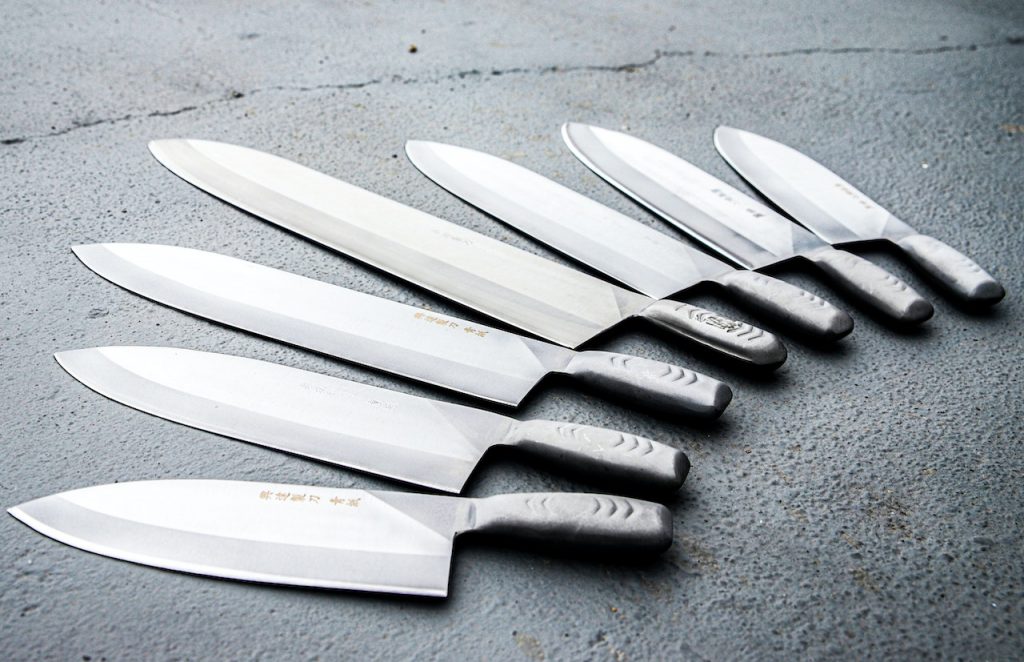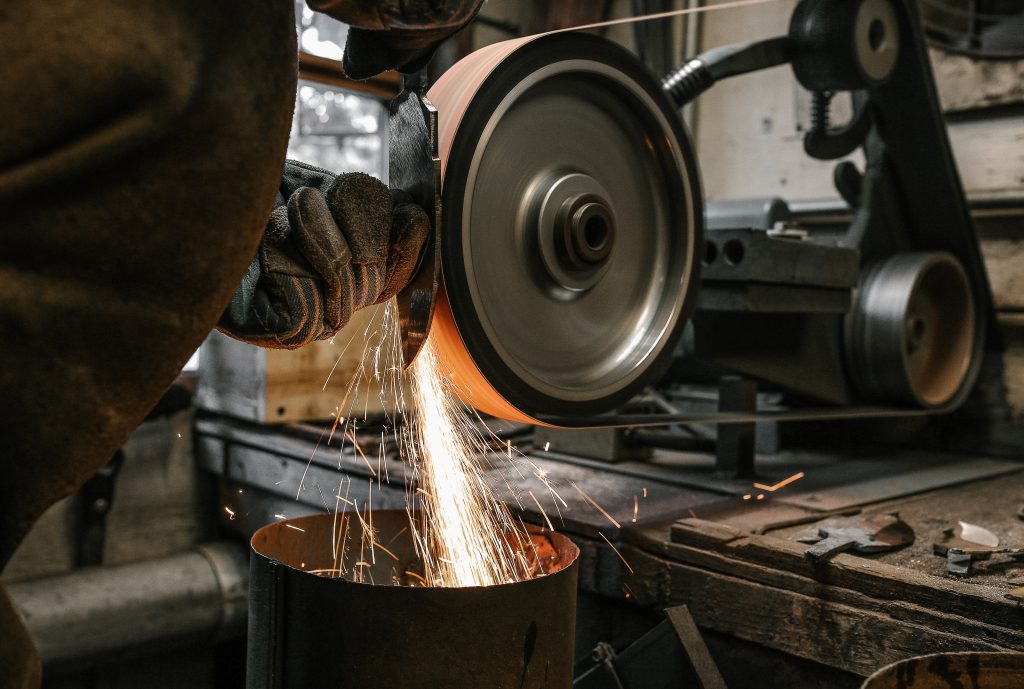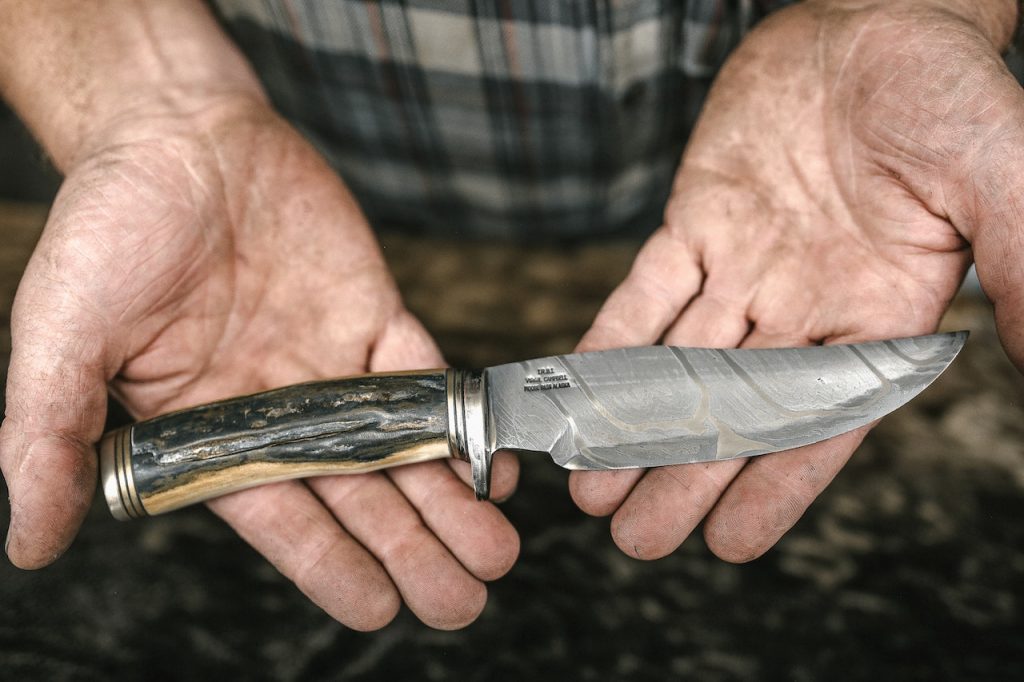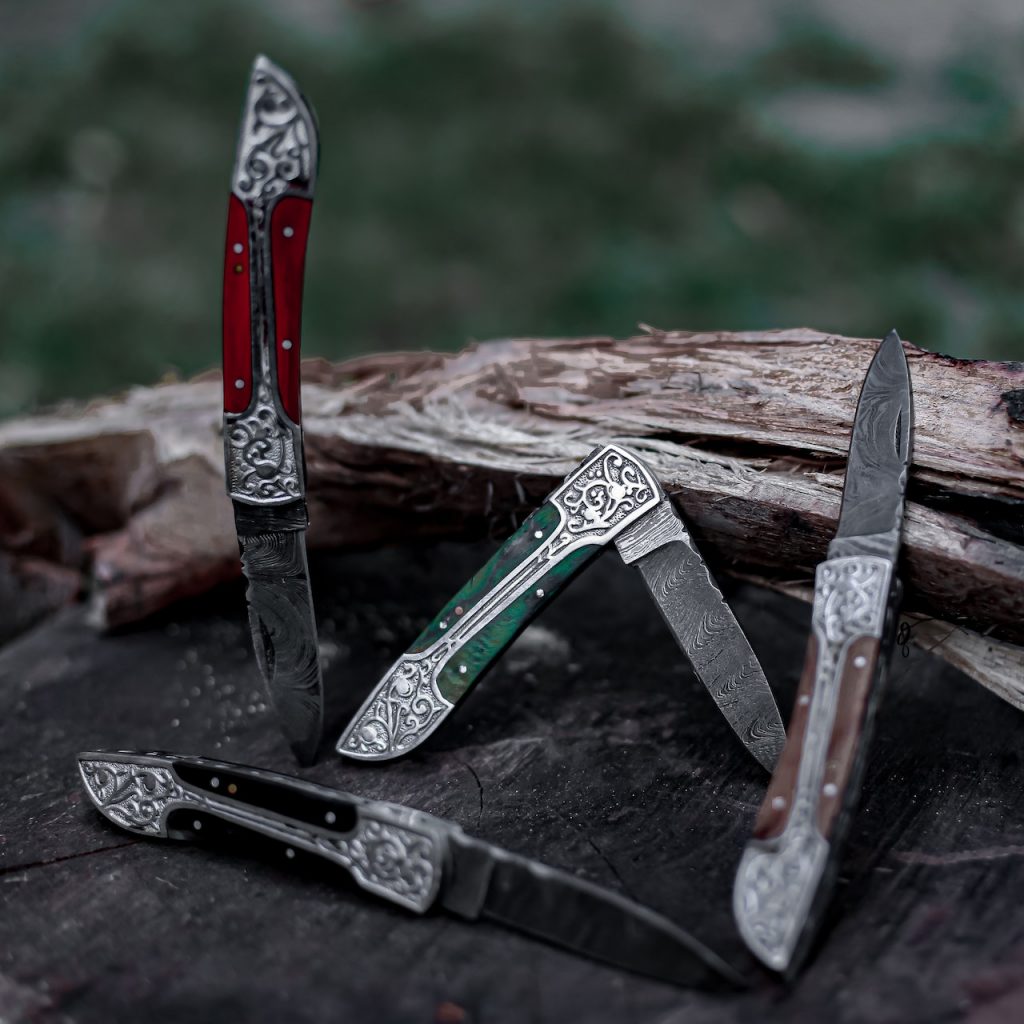Sharp knives are a major source of extreme frustration for many individuals worldwide. When purchasing a knife, you frequently assume that it has exceptional edge retention and that the blade will always be a sharp edge. You probably don’t want to throw away the knife since you previously paid a large chunk of money for it. When a knife grows dull and ineffective, you might wonder how to restore its sharp edge.
A dull knife poses a more significant threat than a sharp edge. Quite simply because cutting with a blunt knife requires significantly more pressure than cutting with a sharp knife. This raises the likelihood that one of your fingers or hands will slip and sever.
Few people have that kind of thinking, so they continue to use the knife even though it is a blunt edge, which finally leads to an accident and a trip to the hospital. We’ll demonstrate how to solve that issue, restore your knives’ effective operation, and restore their sense of security. Let’s start straight now.
Why Do Knives Become Dull?

What causes a knife’s edge to be dull and lose its ability to cut anything? Most people who have spent any time in the kitchen will be aware that the best way to cut with a knife is to use it on the thing for which it was designed.
Too frequently, we hear complaints from people claiming that their knives have broken, lost some of their sharpness, or have minor dents in the blade. They quickly respond when we ask these people if they have ever used their knives to cut through hard surfaces or objects like frozen meat or bones.
Types of Knife Edges
🔪V angle
The most typical edge type for kitchen knives is this one. The “V” designates the blade’s appearance in cross-section, which is flat on both sides and ends at a point. When sharpening a knife, this kind is generally simple to produce and tends to survive longer than other finer-edge types.
🔪Curved edge
With the exception of the surfaces being curved as they approach the point, this is comparable to the V edge. It resembles a bullet a little bit in cross-section. It is still sharp but more substantial than the V edge. This edge will typically become the standard V edge after several sharpening.
🔪Compound blade
Compound blade This kind of edge keeps the edge from “rolling” or cracking, preserving its sharpness and longevity. Elusive to the unaided eye. This edge can occasionally have a convex edge in the last segment, giving the blade a cross-section that looks like a bullet in a cartridge case.
🔪Flat edge
The sides with this type of edge are somewhat hollowed out, opposite the convex edge. The resulting narrow blade is exceptionally sharp but more vulnerable to injury. Frequently found in outdoor and hunting knives.
🔪Razor edge
This is the classic example of a Japanese-style blade, with one side angled like a chisel and the other flat. Two knives used chiefly for making sushi and sashimi are made of it. A lot sharper than German and European-style knives, the edge angle is often 20 to 25 degrees, and as the other side has no angle guide at all, the included angle is also the same. Only with chisel-edge knives does it matter if you are left or right-handed; be sure to purchase the appropriate razor-sharp knife.
🔪Diagonal Edge
Said asymmetrical refers to when the cutting edge on one side differs from the edge on the other. Although chisel edge blades also fall under this category, they are listed individually. Asymmetrical edges can, for instance, originate at a different point on the blade on each side or have a flat surface on one side and a convex or concave surface on the other. The asymmetrical V edge and the asymmetrical convex edge are common asymmetrical cutting edge types.
Different Types of Knife Sharpeners
There are several methods for sharpening a knife, from steel to stone. Not all are interchangeable, though, and each has a very distinct role. Regardless of your method, remember to sharpen both sides of your knife.
🔪Sharpening Metal
A sharp knife is already reasonably sharpened with a sharpening steel, a long, thin rod. Although your steel is excellent for routine upkeep, if your knife is already dull, it is essentially useless.
🔪Sharpening Stone
A sharpening stone is a traditional tool for honing knives and is a mainstay of many commercial kitchens. Why? It is dependable, resilient, and yields a perfectly sharp blade when done properly. While using a stone to sharpen a blade isn’t the fastest way available, it does result in an even edge that slices through most materials without a trace.
🔪Ceramic Dish
This ingenious hack is priceless if you don’t have access to steel or stone and your blades are dull. A ceramic plate’s rough back makes the ideal surface for sharpening blades.
How to Put an Edge on a Knife and Sharpen It

Knives frequently lose their blade edge or become blunt after being used for a while. Occasionally buying a new knife for your kitchen may be unrealistic. For this reason, we have put together a list of simple techniques for a knife. Enjoy.
🔪Creating an Edge
It would be best if you created an edge on your new knife so that you may sharpen it. First, secure the blade in a vice. Then, using a sharp metalworking file, sharpen an edge on it that is neither too thin nor too thick. Make sure you file a similar amount into both sides of a double-sided knife if you want it to sharpen the edge properly.
🔪Knife Sharpening
Repeat this technique on both sides of the knife has two blades. Be sure to file the same amount on both sides once more. If you slip, you may sustain a little cut because a sharp blade doesn’t require much pressure to cut. So, maintain the sharpness of your blades by repeatedly honing both sides.
Insufficient maintenance
People’s disregard for their knife’s edge is another major issue contributing to their becoming dull. Would you leave your car outside if you knew it was about to start raining down golf ball-sized ice shells? No.
Knives should be hand washed right away after use, not eight hours later, and dried right away because the acids in food will eventually cause the blade to rust. If you leave your knives to air dry, they might start to rust. Sadly, when I tell people this, they only implement it for a week at most before abandoning it.
It would be beneficial if you did not also put knives in the dishwasher. Because the knives may cause internal dishwasher damage, but more likely because they may sustain blade edge damage, losing their sharp edge.
Your knives would last a lot longer if you considered all of these factors and handled them the same way you would if you owned a Lamborghini. The knife’s quality is to blame if they still grow blunt quickly. They considered the likelihood that it was a fake and that the knife blade edge maker utilized low-quality steel.
Keys To Caring For Your Knives

🔪Honing and Sharpening
Understanding how to maintain and care for your knives relies heavily on this. In our research, we discovered that while most individuals know little about honing or sharpening, many people have a great deal of experience with the frustration of using a dull blade edge that won’t cut. Master chefs are created to cut with a sharp knife. They won’t finish the task before sundown if they don’t.
A dull knife is harmful and makes a task more difficult to complete quickly. Every time you use the knife, usually just before, you should conduct some honing. It can be completed using an electronic kit or a steel rod to reduce time. Although honing is necessary more frequently sharpen, sharpening is occasionally required. If you need to sharpen a kitchen knife, you will need a sharpening stone and may wish to get guidance from a sharpening expert.
A double-bevel knife must have both edges sharpened to the same degree when honing or sharpening it. Additionally, even pointing motions are preferred because you want one sharpened side to be the same. If the knife has only one bevel, you can sharpen it to whichever angle fits you best on the other side.
A sharp knife will either be protected or further harmed depending on how it is stored. Knives should be kept in a block or on a magnetic strip for safety. Knife blocks of wood offer excellent protection and won’t dull or harm the blade.
Knives can be stored on magnetic strips, but you should be cautious. Avoid pressing the knife directly against the strip, as this could harm it. Checking the magnetic strip’s strength is also a good idea since if it loses its magnetic pull, the blade could come off and end up in pieces on the ground.
Both methods for storing a knife are secure, efficient, and practical. Throwing a knife into a drawer with a lot of other cutlery should be avoided since the other silverware will bang on the knife’s edge when closed and opened.
🔪Drying and Washing
The one thing that will damage a knife the quickest is washing it. Sharp knives can only be properly maintained by hand cleaning; however, they should be kept from the sink for extended periods. They will become filthy after use and need to be cleaned right away. They will begin to rust if you leave them in the sink because of all the chemicals and acids in the meal.
Hand-washing chef knives or sharp knives may take more time, but it is the best way to care for them and extend their lifespan. If you opt to put a knife in the dishwasher, it could cause harm to the appliance and erode the blade. Although some knives can go in the dishwasher, this is still up for debate because we don’t know for sure.
🔪Using the Appropriate Cutting Board
When you’re engaged in the kitchen, where cutting food is crucial, it can blow over your head. It would be beneficial if you took a moment to check that you have the right cutting board and knife before beginning to cut. The blade may become harmed if you use the incorrect cutting board; for example, a plain-edge knife will suffer if you use a glass cutting board.
Vegetables should be chopped into small pieces and diced perfectly on a cutting board made of wood, such as bamboo. Vegetables should also work perfectly on a plastic board. Especially if the countertop is made of marble or another hard surface material, you should refrain from cutting anything on it. Blades, particularly serrated knives, can sustain significant damage from this. Numerous people still make this error even after knowing how to maintain and care for their knives.
Essential Tips On How To Clean A Knife
Nobody imagines that a Swiss Army knife or a Leatherman would require frequent cleanings and meticulous maintenance. The most potent natural forces are expected to be able to withstand these sturdy pieces of machinery! We should be fine with researching how to properly clean a knife. We would suggest you divert your attention from that line of thinking and understand the facts about these knives and knives in general because this is not the case and is, for the most part, total hogwash. There isn’t much to it, so let’s get started with this tip.
🔪Find Cleaning Equipment
We’ll need a few pieces of helpful equipment to aid in the cleaning process, so let’s get that out of the way first. When cleaning knives, many different methods may be used, and depending on the type of knife, we may need to be able to select from a variety of methods. We advise using towels, tissue paper, toothbrushes, and toothpicks, among other cleaning supplies. These are only a few items you can use, but they are quite simple to find around the house.
🔪Clean It Up
This shorthand means “Get everything obvious out of the knife.” This is crucial if you’re learning to clean a chef’s knife because you can rinse the grime at the sink. To learn how to clean a folding knife properly, start with this step, which primarily applies to pocket knives. Before removing the lint lodged in the handle piece, avoid getting that nasty boy wet. This will make it difficult to open the knife, making cleaning even more difficult. After opening the knife, we suggest blowing forcefully into it and giving it a quick swab with a q-tip. You are then prepared to continue.
🔪Rinse it Through a Hot Tap
Any knife you are cleaning has likely had dirt accumulating in and around the cracks and holes for a while. It takes routine cleaning to keep a knife in peak condition at all times unless you already know how to clean a knife well, in which case I’m not sure why you’re still reading. Knives will have gunk and grime in the hardest-to-reach areas, so you might want to run it under hot water to loosen up some of that tough crud. It’s doubtful that anyone regularly practices cleaning knives, or perhaps it’s their profession.
🔪Regarding Knives With a Lot of Tools
Some knives, like the Swiss Army knife, are jam-packed with features. Given the variety of tools, a knife contains, cleaning one is not easy. Unfortunately, cleaning knives like these requires doing each tool individually; there is no shortcut. Open the knife, take everything out, and follow steps 1 through 5 until you know all the mud and sludge are removed. You’re now prepared to continue.
How to Make a Knife Edge Even

The sharpening stone should first be set down on a counter, preferably with a moist cloth underneath to keep it from sliding. The next step is to use your palm to clean the stone. Remove any residue by doing this to ensure that the blade makes even little contact with the stone.
Second, you should set the razor-sharp knife on the stone with the blade pointed away from you and at a shallow angle to the stone. Imagine that you lay the stone’s blade flat so that it is parallel to the table, and then you slowly lift the knife’s spine. Maintain contact with the rock with the knife’s cutting edge as you do this. Start shallow and work your way deeper because the angle gets more profound the more weight you lift.
Thirdly, you should cut the stone by lightly brushing the knife across it. But only do this with shallowly angled forward strokes away from your body. Avoid pulling the blade away from the stone. As you would while cutting something, you should instead push in the opposite direction to sharpen the stone.
Finally, you must ensure that whatever you do on one side, you also do on the opposite side. Therefore, make two strokes, turn the knife over and repeat the process on the other side. The previous stance should be used. Your knife should be as good as new after performing this 10 to 15 times.
Frequently Asked Questions
What angle does a knife edge have?
Most kitchen, pocket, and outdoor knives have an angle between 17 and 20 degrees. Some producers of knives, usually Japanese ones, may sharpen their blades to about a 17-degree angle. Western knives often have a 20-degree angle. In reality, for most knives, a 20-degree angle is frequently seen as the optimal sharing point.
Why are the knife edges collective unity?
For the reaction at each end to be the same, the beam must be symmetrically positioned on the knife edges, with an equal portion of the beam extending from each knife edge. Positioning the beam symmetrically while evaluating both uniform and non-uniform bending is crucial.
Does the way you sharpen a knife matter?
Use a small, portable sharpener and move the blade in almost a straight line. Always remember to cut into the stone rather than pulling or dragging your edge backward. The edge of the blade should be facing the direction of your stroke. In essence, you are removing the metal away from the edge.
Which blade form is the most durable?
True spears’ point blades have a core spine and a double edge, just like a dagger or spearhead. The spear point, which may be found on many thrusting knives, including the dagger, is one of the strongest blades in penetrating stress.
Which knife is the greatest overall?
A kitchen Knife is the most used knife. With this knife, you can chop, slice, and julienne just about anything in addition to carving a roast or dissecting a watermelon. It should have a long blade, a grip that is comfortable in your hand and be made of sturdy but lightweight material.
Final Words
That is how a knife gets an edge. Sharpening is crucial, but so is everything else bundled into one labor-intensive operation. Your knife becomes razor-sharp as a result of all of this, and it stays that way.
Sharpening is simpler if you have a knife with a single angle. This is so that you just need to sharpen one side and don’t have to worry about the angles being even. So hopefully, you now understand how to sharpen a knife. Additionally, we wish you continued care for your knives.
Want to know more about how good are henckels knives? Just click here!
